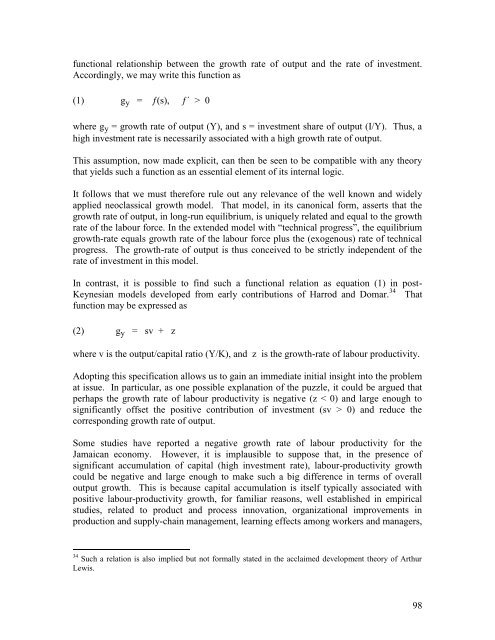PIOJ Growth-Inducement Strategy - Planning Institute of Jamaica
PIOJ Growth-Inducement Strategy - Planning Institute of Jamaica
PIOJ Growth-Inducement Strategy - Planning Institute of Jamaica
Create successful ePaper yourself
Turn your PDF publications into a flip-book with our unique Google optimized e-Paper software.
functional relationship between the growth rate <strong>of</strong> output and the rate <strong>of</strong> investment.<br />
Accordingly, we may write this function as<br />
(1) g y = ƒ(s), ƒ´ > 0<br />
where g y = growth rate <strong>of</strong> output (Y), and s = investment share <strong>of</strong> output (I/Y). Thus, a<br />
high investment rate is necessarily associated with a high growth rate <strong>of</strong> output.<br />
This assumption, now made explicit, can then be seen to be compatible with any theory<br />
that yields such a function as an essential element <strong>of</strong> its internal logic.<br />
It follows that we must therefore rule out any relevance <strong>of</strong> the well known and widely<br />
applied neoclassical growth model. That model, in its canonical form, asserts that the<br />
growth rate <strong>of</strong> output, in long-run equilibrium, is uniquely related and equal to the growth<br />
rate <strong>of</strong> the labour force. In the extended model with “technical progress”, the equilibrium<br />
growth-rate equals growth rate <strong>of</strong> the labour force plus the (exogenous) rate <strong>of</strong> technical<br />
progress. The growth-rate <strong>of</strong> output is thus conceived to be strictly independent <strong>of</strong> the<br />
rate <strong>of</strong> investment in this model.<br />
In contrast, it is possible to find such a functional relation as equation (1) in post-<br />
Keynesian models developed from early contributions <strong>of</strong> Harrod and Domar. 34 That<br />
function may be expressed as<br />
(2) g y = sv + z<br />
where v is the output/capital ratio (Y/K), and z is the growth-rate <strong>of</strong> labour productivity.<br />
Adopting this specification allows us to gain an immediate initial insight into the problem<br />
at issue. In particular, as one possible explanation <strong>of</strong> the puzzle, it could be argued that<br />
perhaps the growth rate <strong>of</strong> labour productivity is negative (z < 0) and large enough to<br />
significantly <strong>of</strong>fset the positive contribution <strong>of</strong> investment (sv > 0) and reduce the<br />
corresponding growth rate <strong>of</strong> output.<br />
Some studies have reported a negative growth rate <strong>of</strong> labour productivity for the<br />
<strong>Jamaica</strong>n economy. However, it is implausible to suppose that, in the presence <strong>of</strong><br />
significant accumulation <strong>of</strong> capital (high investment rate), labour-productivity growth<br />
could be negative and large enough to make such a big difference in terms <strong>of</strong> overall<br />
output growth. This is because capital accumulation is itself typically associated with<br />
positive labour-productivity growth, for familiar reasons, well established in empirical<br />
studies, related to product and process innovation, organizational improvements in<br />
production and supply-chain management, learning effects among workers and managers,<br />
34 Such a relation is also implied but not formally stated in the acclaimed development theory <strong>of</strong> Arthur<br />
Lewis.<br />
98
















